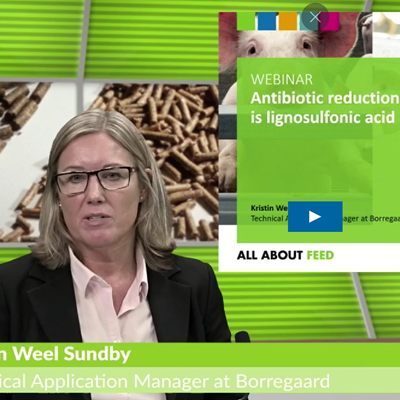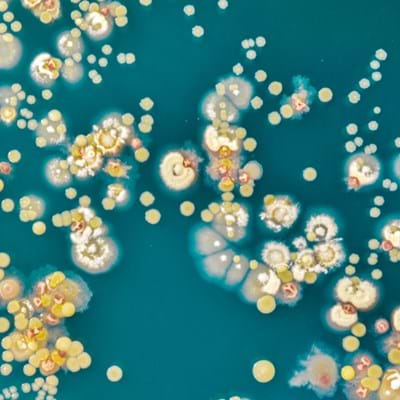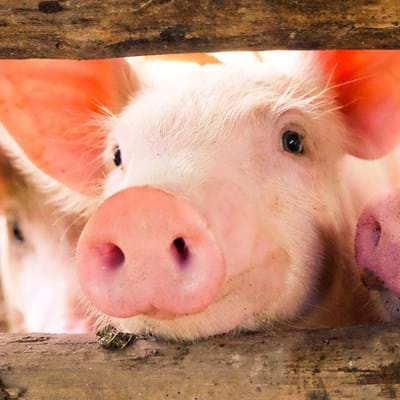
About Bacterial Inhibition
1. Bacterial and mould inhibition
People and animals have been exposed to infections/diseases for thousands of years.
Scientists had suspected the existence of microorganisms for a long time. However, it was the invention of the first primitive microscope in 1664 that led to their discovery.
Because of this invention, we started to understand the nature of microorganisms. Questions about the nature of pathogens and the nature of infections/diseases needed to be answered. Development of new and better microscopes together with better analytical techniques led to increased knowledge of bacteria, moulds and fungi.
To fight these pathogens, an emerging industry of synthetic antibiotics started to grow. Over the years, millions of synthetic products and microorganisms have been screened and characterised.
Penicillin is perhaps one of the most famous antibiotics known to fight bacterial infections. Before the discovery of this antibiotic, diseases like tuberculosis, pneumonia and gonorrhoea, could not be treated.
However, after some decades, resistance to antibiotics became evident. This led to an EU ban of antibiotics used in livestock animals in 2006. The industry had to look for alternative antimicrobial agents.
Today, prebiotics, probiotics, zeolites/phytochemicals, enzymes and organic acids/inorganic acids are common alternatives.

Figure A copy of the first microorganisms seen through a simple microscope
2. What is bacterial/microbial inhibition?
First, we will look at what makes bacteria, moulds and yeast grow. Other microorganisms like parasites, protozoa and viruses are also present in the food and feed industry but will often have more complex mechanisms and are not covered here.
There are several factors affecting microbial growth:
- The matrix of the feed (a source of nutrients for the bacteria to grow on),
- The acidity of the feed material - depending on the pH, the bacteria, mould and yeasts will have favourable/non-favourable conditions to grow on
- Temperature- and moisture levels will also influence the magnitude of growth.
- Microbial growth can occur either under aerobic or anaerobic conditions; i.e., with or without oxygen. Depending on the microorganism, this will impact growth either positively or negatively.
- Time is also relevant and will impact potential colonisation of bacterial cells and, hence, the magnitude of growth.
Microbial growth can be controlled either by prevention or inhibition – using an antimicrobial agent.
3. Why is bacterial/microbial growth inhibition important?
Although microorganisms are very small in size, too small to be seen by the eye, they cause substantial economic losses each year for both the food and feed industry.
Business World magazine mentions some aspects related to the feed/aqua feed business:
Bacterial infections caused by Salmonella, Campylobacter and Escherichia Coli are perhaps the most common infections causing billion-dollar losses.
Reports estimate that Salmonella and Campylobacter infections in the poultry industry are responsible for 9 out of 10 reported food-borne diseases globally. Coliform infections (E. coli) also cause major concerns related to mortality in chickens.
Aquafeed is a growing business globally. However, the industry faces big challenges due to microbial diseases contributing to losses in the sector. An estimate published in Business World magazine (Feb.2020) suggests that microbial diseases cost the aquaculture industry around 6 billion USD per year.
As mentioned earlier, antibiotics have been used for decades to fight bacterial diseases. Emerging resistance and the ban of antibiotics in the European Union from 2006 have affected this multi-billion dollar industry enormously. Alternatives have been tested with varying results.
4. What methods exist to inhibit bacterial growth?
Several technologies have been developed to control unwanted microorganisms in food and feed. Both physical and chemical sterilisation methods can be applied.
In animal feed production, the temperature normally exceeds 80℃ for several minutes during conditioning and pelleting. This heat treatment will prevent growth of microorganisms like Salmonella and E. coli.
Two physical methods commonly used in the dairy industry are pasteurisation and sterilisation. When milk is pasteurised, it is heated to a temperature that will kill microorganisms without having a detrimental effect on the taste of the milk. The heat treatment is usually followed by a quick cool-down.
Sterilisation occurs when a higher temperature is reached. This method not only kills the microorganisms (bacteria, fungi, viruses, etc.), but also destroys potential surviving spores. It is possible to use sterilisation in combination with, for instance, ultraviolet radiation.
Sterilisation with chemical agents, alone or in combination with heat, is another method. Chemical agents include: chlorine dioxide gas, phenol derivatives, guanidine compounds and hydrogen peroxide gas.
Alternative products like prebiotics, probiotics, zeolites/phytochemicals, enzymes and acidifiers/organic acids also offer bacterial/microbial inhibition. Organic acids are widely used in animal feed. They have an excellent antibacterial effect on bacteria, mould and pathogenic yeasts.
5. What is an acidifier?
Several definitions have been proposed, one of them being:
“Compounds classified as organic or inorganic acids. Organic acids include formic, fumaric, lactic, benzoic, propionic, and citric acids. Inorganic acids include hydrochloric, sulfuric, and phosphoric acids. Salts of acids also have been used as acidifiers, including calcium-formate, potassium-diformate, sodium-diformate, and sodium-fumarate. Blends of acidifiers are often commercially available because organic and inorganic acids may have a synergistic effect. In addition, some commercial acidifiers contain protected acids that are coated with fatty acids or other molecules, mainly to allow the release of the acid in a targeted location in the gut with the goal to improve effectiveness (Kansas State University, Upadhaya et al., 2014).”
6. Where are feed acidifiers used?
The animal feed industry uses acidifiers in a number of different applications. Here are some examples of applications where Borregaard's unique SoftAcid products perform very well:
7. What types of feed acidifiers exist?
The EU Register of Feed Additives provides an overview of a limited number of authorized feed additives. Some of the products are currently under re-evaluation, implying that changes might occur in the near future.
Organic acids and their salts are listed as technological feed additives. In addition, there are compounds divided into sub-groups according to their functionality: acid regulators, zootechnical additives, preservatives and silage additives.
The current list can be found under Annex I here:
https://ec.europa.eu/food/safety/animal-feed/feed-additives/eu-register_en
Pure organic acids often used in the feed industry today are formic, fumaric, lactic, benzoic, propionic, and citric acid.
Inorganic acids include hydrochloric, sulfuric, and phosphoric acid.
Salts of organic acids (buffered acids) have also been used as acidifiers, along with blends. Blends of acidifiers are often commercially available because organic and inorganic acids may have a synergistic effect.
Borregaard's unique SoftAcid® technology consists of organic acids and modified lignosulfonic acid. It is the presence of the latter that gives the product its name “Soft,” due to its ability to moderate the aggressive nature of the organic acids, without reducing efficiency.
8. How do feed acidifiers work?
Organic acids have two functions as antimicrobial agents. Their primary antimicrobial action is through pH depression. In addition, the ability of the organic acids to change from undissociated to dissociated form, depending on the environmental pH, makes them effective antimicrobial agents. An acid in the undissociated form can freely diffuse through the semipermeable cell wall of the microorganism into their cell cytoplasm (Figure 2).
Once inside the cell, where the pH is maintained near 7, the acid will dissociate: The H+ ion releases and as a result the pH will decrease. A change in pH will suppress cell enzymes and nutrient transport systems (Lueck, 1980).
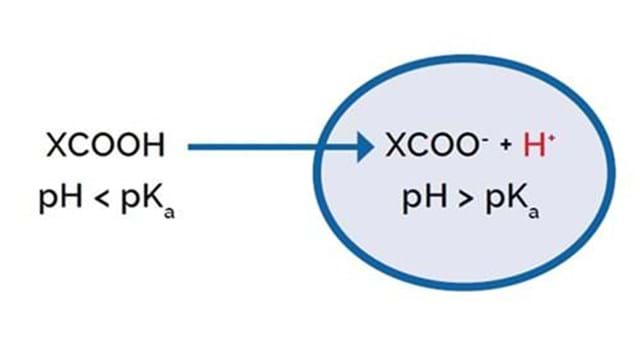
Figure Undissociated acid diffuses through the semi-permeable cell wall of the microorganism
The efficacy of an acid in inhibiting microbes is dependent on its pKa value, which is the pH at which 50% of the acid is undissociated.
Organic acids with higher pKa values are more effective preservatives over a wider pH range because of more acid in its undissociated form in the relevant pH range. Their antimicrobial efficacy generally improves with increasing chain length (Foegeding and Busta, 1991).
Different types of acidifiers exist, but we recognise some common features regarding how they work:
- You can distinguish between a strong and a weak acid by using the acidity constant, pKa.
- pKa differs for each acid and can vary over many orders of magnitude.
- Strong acids have a low pKa value.
- Weak acids have a higher pKa value.
The table below shows pKa values for some common organic acids.
|
Carboxylic acid |
pKa |
|
Formic acid |
3.8 |
|
Acetic acid |
4.8 |
|
Propionic acid |
4.8 |
|
Lactic acid |
3.9 |
9. What are the costs and benefits of using an acidifier?
Fefana has highlighted several aspects of using organic acids in the animal feed sector:
“Between 50 and 80% of the total cost of poultry and pig production in Europe relate to feed. Therefore, it makes sense to improve the efficiency of turning feed into animal growth.
In Germany, the largest economy in the EU, more than 70 kg of pork and poultry are consumed per capita per year, showing the scale of the need to improve feed efficiency, cost of production and environmental impact. Controlling the balance of the intestinal microbiota is the foundation of a profitable modern livestock operation. The maintenance of a stable microflora within the digestive tract is a key aspect in achieving optimal feed efficiency; it also impacts food safety and animal welfare. A holo-analysis of organic acids’ use in pig nutrition has revealed that feed efficiency (Feed Conversion Ratio, FCR) can be improved by an average of 3.7%. Assuming an overall FCR of 2.2 from the piglet to the fattener and a slaughter weight of 100 kg, this average improvement of feed efficiency of 3.7% would result in a saving of 8 kg feed per pig.
Comparable calculations could be applied to poultry production, which is expected to become the largest source of meat worldwide in the next few years. In a trial with broilers using a granulated premixture including benzoic acid, an improvement in FCR from 1.89 to 1.81 resulted in a feed saving of 180 g/bird.
Similar results with protected acids are expected in aqua culture, which is currently the fastest growing meat production sector worldwide. The use of organic acids for sanitizing feed or water can reduce mortality on the farm and thereby improve the overall efficiency of feed use and production cost.“
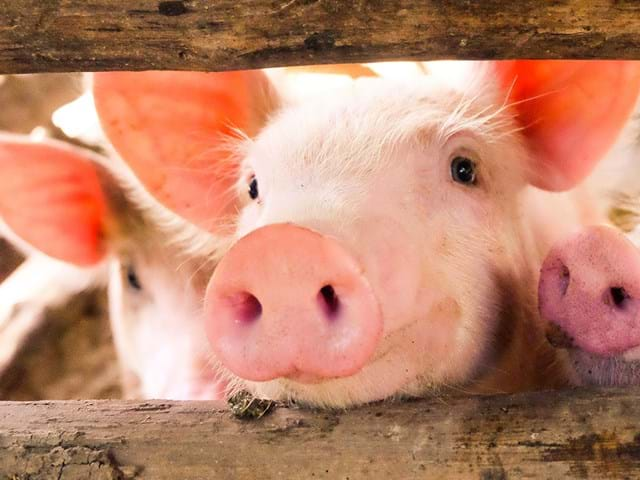
Between 50 and 80% of the total cost of poultry and pig production in Europe relate to feed.
10. What are the Safety, Health and Environmental (SHE) aspects of using acidifiers?
Several accidents in the chemical industry eventually led to the first initiative of SHE management (1985). A few years later, we got the first industry standards and guidelines for corporate environmental conduct.
Today, ISO 14001 (Environmental Management) and ISO 45001 (Occupational Health and Safety Management) are common company standards. In 1998, the International Finance Corporation established the SHE guidelines.
Most acidifiers are corrosive and pose handling and equipment risks during use. Both the work environment (evaporation to air) and the physical handling of acidic products by workers can be a challenge.
SoftAcid products from Borregaard contain lignosulfonic acid in combination with one or more organic acids. The lignosulfonic acid is manufactured from wood. The presence of lignosulfonic acid renders the products less corrosive. Available data (Life Cycle Analysis) show that this natural biopolymer has very low toxicity towards aquatic and terrestrial species. Hence, it can be regarded as an eco-friendly alternative when used in combination with organic acid.
You may also want to consider the eventual breakdown components of the different types of acidifiers. The nature of potential decomposition products, as well as where they end up, should be evaluated to find a sustainable alternative. Choosing sustainable products have become increasingly important to many producers.
11. How to choose the right feed acidifier?
The search for antibiotic-free products has led to research on other products managing gut health, as well as for reduction of bacteria/pathogens.
Acidification will lower the pH and reduce/kill the population of unwanted bacteria like Salmonella, Campylobacter and Clostridia before they reach the digestive tract of the bird/animal.
Acidification is now used in animal feed/wet feeding, as well as in drinking water systems.
When choosing an acidifier, it is essential to understand the type of microbial challenge you may have. Formic acid based products are often used if bacteria are causing problems. If mould and yeast represent the problem, formic and propionic based products may be more suitable. Acid blends which target several problems are also commonly used.
Generally, it is important to pick an acidifier that lowers the pH enough to inhibit or prevent growth of the bacteria causing the problems. The correct dosage recommended by the producer is, hence, vital to get the desired treatment.
The economic side is also essential: efficiency in animal feed production, nutritional value and reduction in compound feed losses are factors that can be negatively impacted by microorganisms.
When selecting which acidifier to use, one should also consider how it affects the surrounding ecosystems when it eventually breaks down.
12. How to apply an acidifier?
Acidifiers are either powder or liquid products. Usage and dosage depend on the area of interest.
Feed/Wet feeding
Piglets are susceptible to pathogenic bacteria and are easily prone to problems like diarrhoea and early death. Acidification of the feed with dosages from 6-9 kg/tonne dry feed is recommended.
In pig feed you want to keep a balanced microbial flora with dosages of 3-5 kg/tonne.
Drinking water systems
In drinking water systems, acidification is done to a target pH – usually between 3.8 and 4.2.
Raw material preservation
Propionic and/or formic based acids are often used to preserve cereals and grains. Mould and yeast can often cause problems and give nutritional loss if the cereals are not treated. Dose will depend on the raw material and the moisture content.
TMR (Total mixed ration)
When feeding cows, home mixing with green fodder – especially silage mixed with concentrates - contributes to making a balanced ratio for the cow.
In the absence of preservatives/acidifiers, one can experience heat generation (due to bad fermentation). To avoid this, acidification directly in the mixing bin or on the TMR blend itself is essential. Typical dosages are 2-4 kg/ton feed.
Fish silage preservation
Fish silage consists of intestines, bones, skin and some meat. It is mixed with conservation agents to stabilise the silage against degradation. Acidifiers are often used as conservation agents, particularly organic acids, due to their antibacterial effect. Depending on the amount of fish bones present, typical dosages to achieve a pH between 3.5-3.8 are used.
Equipment
There is a variety of equipment that can be used for the applications mentioned.
Typical pumps are:
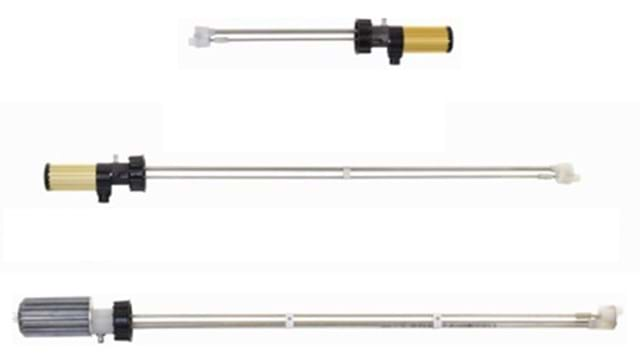
Figure Serigstad-pumps to be connected directly to the can (upper), barrel (mid) or IBC (bottom).

Figure IWAKI membrane pump for liquid dosing.
13. Conclusion
Acidifiers are very useful when there is a microbial imbalance and conditions are challenging. In some cases, their use is even critical.
There is a diversity of needs and, hence, a corresponding variety of microbial inhibitors available. Animal welfare, sustainability and cost versus performance for microbial inhibition are some of the decisive factors to consider when choosing an acidifier.

